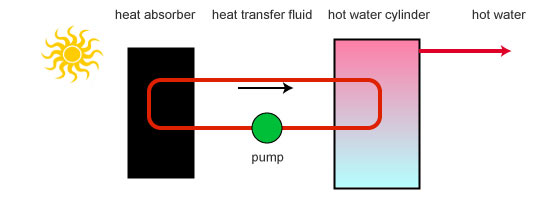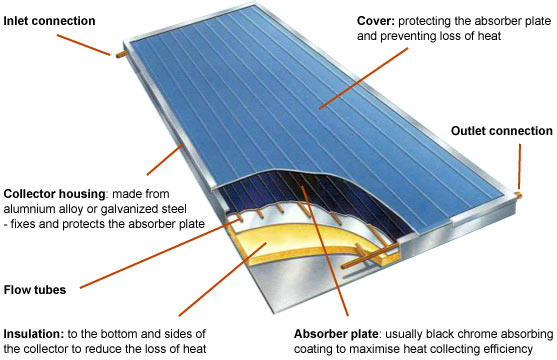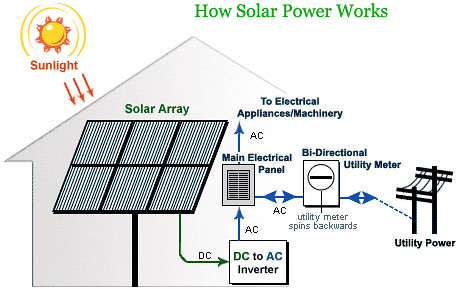 A solar collector is a device that absorbs heat from the sun which is then used directly or stored in a tank inside the home. Collectors can be used for both building heating and domestic hot water heating. Here is a very basic diagram showing how it works.
A solar collector is a device that absorbs heat from the sun which is then used directly or stored in a tank inside the home. Collectors can be used for both building heating and domestic hot water heating. Here is a very basic diagram showing how it works.The principle is similar to leaving a garden hose out on your lawn on a sunny day - the water will come out warm. Collectors are much more efficient and sophisticated version of this.
There are essentially two types of collectors. Flat plate collectors are often confused for solar panels because they are large rectangular devices with glazing on the front. Inside there are sheets of black metal heat absorber material coupled to copper plumbing.
The other type of collector is an evacuated tube collector like this:
These collectors have a heat absorber pipe inside something that is similar to a glass thermos bottle. Heat is transferred to the plumbing manifold header at the top. The vacuum glass tube prevents heat loss and improves efficiency.
On my property I use flat plate collectors on my house to heat water, and on my workshop building to heat the building via radiant floor and radiators. Both systems also use small solar panels to provide electricity for the circulation pumps that pump the antifreeze fluid through the collector to the storage tank. Due to the lower cost compared to solar electric panels, both of these systems generally have had a much shorter return on investment than solar electric systems.
Solar electric panels are made from arrays of solar cells that generally have a blue cast to them. Each panel is framed in aluminum with a glass front.
 |
| Solar panel consisting of solar cells |
Photovoltaic (PV) panels produce electricity directly from sunlight. This electricity is DC (like a battery) and flows in one direction only so it must be converted into AC (alternating current) in order to provide power to our homes. An electronic device called an inverter performs this function.
Power is sent from the inverter to the main electrical panel in your house. If the solar array is generating more power than you are using in your house, then the utility meter runs backwards. In most places, the utility credits you for the energy you feed back into the grid. In a sense you are banking this energy for future use and using the utility as your storage medium. In an off-grid solar power system energy is stored in batteries for use overnight and when there is no sun.
My solar array consists of 31 panels, each with its own micro inverter that converts the power to 240 V AC right behind each panel. In the summer I have an energy surplus that is banked and used up in the fall.
 |
| Solar electric array on left and collectors on right |
I hope this helps to clarify the difference between these two renewable energy sources.




thanks for great content
ReplyDelete